



Non-Venomous Snakes
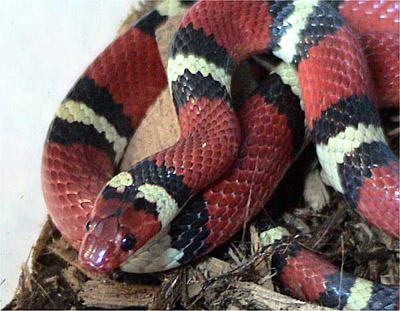
Name: Kingsnake -The "king" in their name (as with the king cobra) is a reference to their taste for other snakes.
Size: Typically 2 to 4 feet, rarely 7 feet, hatchlings 8 to 13 inches.
Habitat: Found in the United States from central Arkansas and southeastern California. Found in areas ranging from flat coastal plains to steep rocky canyons and hillsides. It is associated with many different vegetation types, including desert, sandy creosote areas, mesquite grassland, desertscrub, and pine-oak forests. Towards the southern edge of its range, this species may be found in thornforest and tropical deciduous forest.Most rattlesnakes mate in the spring. All species give live birth, rather than laying eggs. The young are self-sufficient from birth. As they do not need their mother after birth, the mother does not remain with her young.
Danger:
It's non-venomous and Kingsnakes are commonly kept as pets, due to their ease of care. There are several mnemonic rhymes to help people distinguish between the coral snake and its non-venomous look-alikes, such as "If red touches black, it's OK, Jack. If red touches yellow, you're a dead fellow." and "Red and yellow, kill a fellow. Red and black, friend of Jack." and "If yellow follows red, you're dead." These rhymes refer to the color of the rings on the snake, and only apply to those coral snakes found in the United States.
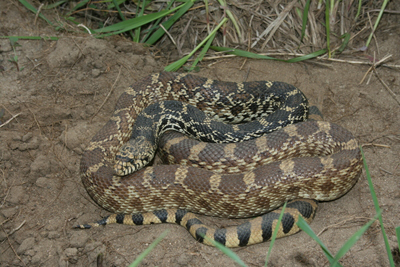
Name: Gopher Snake or Bull Snake
Size: Bullsnakes often exceed 6 feet (1.8 m) in length, and some specimens of up to 100 inches long. This makes them among the largest US snakes.
Habitat: Bullsnakes can be found throughout the central United States,They are usually yellow in color, with brown, black or sometimes reddish colored blotching. The blotching pattern is as follows: fat blotches on top, three sets of spots on the sides, and bands of black on the tail.The bull snake will commonly vibrate its tail rapidly amongst the brush or leaves, and flatten its head to make it take on a more characteristic triangular-shaped head of the rattlesnake. These defensive behaviors are meant to scare away threats, not sound an attack.
Danger:
non-venomous, Though some bull snakes can be docile, and with some time become accustomed to handling, most bull snakes are quite defensive and known for their perceived "bad attitude". Bullsnakes eat small mammals, such as mice, rats, large insects, as well as ground nesting birds, lizards, and the young of other snakes. Juvenile bull snakes depend on insects, small lizards and baby mice.
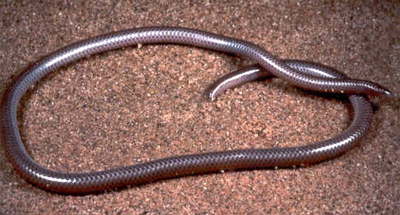
Name:Western Blind Snake / Thread Snake
Size: Less than 30 cm in length. They resemble earthworms and fluoresce under ultraviolet blacklights.
Habitat:
The snake lives underground, sometimes as deep as 20 meters. The snake's skull is thick to permit burrowing, and it has a spine at the end of its tail that it uses for leverage.
Food: Their diet consists mostly of termites or ants, their larvae and pupae. Most species suck out the contents of insect bodies and discard the skin.
Danger:
Not dangerous to humans
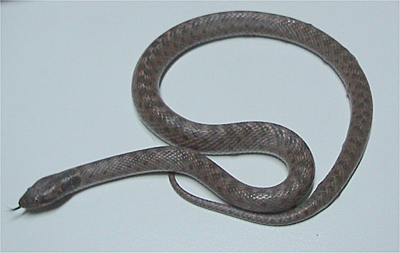
Name:Night Snake
Size: Night Snake grows from 12 to 26 inches (30 to 66 cm) in length, with hatchlings about 7 inches.
Behavior:
As their common name implies, they are a primarily nocturnal snake. Their diet consists of primarily lizard, but they will also eat smaller snakes and occasionally soft bodied insect. They prefer semi-arid habitats with rocky soils.
Danger:
They are considered to be rear-fanged venomous, but not dangerous to humans.
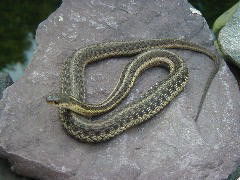
Name:Garden snakes or gardner snakes or even "garder snakes".
Size: Most garter snakes are under 60 cm (24 inches) long, but can be larger.
Habitat:
From marshes to hillsides to drainage ditches and even vacant lots, in both dry and wet regions, with varying proximity to water and rivers. However, in the western part of North America, these snakes are more water loving than in the eastern portion.
Food: Garter snakes, like all snakes, are carnivorous. Their diet consists of almost any creature that they are capable of overpowering: slugs, earthworms, insects, leeches, lizards, spiders, amphibians, birds, fish, toads and rodents. When living near the water, they will eat other aquatic animals. Food is swallowed whole. Garter snakes often adapt to eat whatever they can find. Although they dine mostly upon live animals, they will sometimes eat eggs.
Danger:
They are harmless to humans.Garters were long thought to be nonvenomous, but recent discoveries have revealed that they do in fact produce a mild neurotoxic venom. Garter snakes are nevertheless harmless to humans due to the very low amounts of venom they produce, which is comparatively mild, and the fact that they lack an effective means of delivering it.
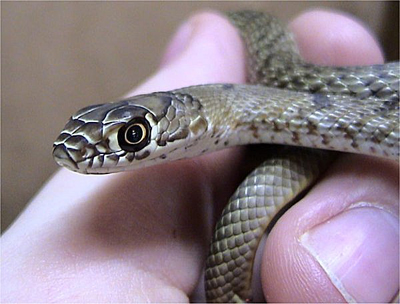
Name: Coachwhip / Whip Snake
Size: Adult sizes of over 160 cm (63 in) are not uncommon.
Habitat:
Coachwhips range throughout the southern United States from coast to coast.Typically they are found in open grassland type habitat, but can also be found in lightly forested areas.Coachwhips are a diurnal snake, and actively hunt and eat lizards, small birds, and rodents. They tend to be high-strung, and often bolt at the first sign of a potential threat. They are extremely fast moving snakes.
Danger:
It is a species of non-venomous. A myth of the rural southeastern United States is of a snake that, when disturbed, would chase a person down, wrap him up in its coils, whip him to death with its tail, and then make sure he is dead by sticking its tail up the victim's nose to see if he is still breathing. In actuality, coachwhips are nowhere near strong enough to overpower a person, and they do not whip with their tails, even though it is long and looks very much like a whip. Their bites are also harmless.
Some Links to information about non-venomous snakes:
- Kingsnake, DesertUSA.
- Gopher Snake, DesertUSA.
- Western Blind Snake, Arizona-Sonora Desert Museum.
- Garter Snake, Melissa Kaplan's Herb Care Collection.
- Snakes, Snakes of Arizona.
Photo Credits:
Kingsnake - Dawson (Creative Commons Attribution ShareAlike 2.5 License), Bullsnake - Psyon (Creative Commons Attribution ShareAlike 3.0 License), Blind Snake - Eugene van der Pijll, USGS (Public Domain), Night Snake - (Creative Commons Attribution ShareAlike 2.5 License), Garter Snake - Fish Cop (Public Domain), Coachwhip - Dawson (Creative Commons Attribution ShareAlike 2.5 License).The information on this page was taken from Wikipedia under a GNU Free Documentation License unless otherwise noted.









